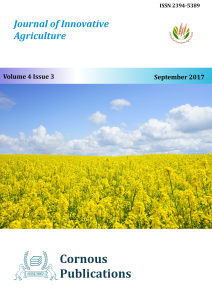
Journal of Innovative Agriculture
Peer Reviewed Open Access Journal
ISSN: 2394-5389 NAAS Rate: 4.05
Submit Manuscript
Peer Reviewed Open Access Journal
ISSN: 2394-5389 NAAS Rate: 4.05
Submit ManuscriptA field experiment was carried out to study the response of tomato to foliar application of micronutrients from 2011 to 2014 at the Department of Vegetable Crops, Horticultural College and Research Institute, Tamil Nadu Agricultural University, Coimbatore. The hybrid COTH 2 was chosen for this study. The results based on three years mean revealed that out of fourteen different treatments, Different combinations of all the micronutrients were applied in three replications. The pooled analysis revealed that among the different combinations. In tomato hybrid COTH 2, spraying of mixture of all micronutrients (Boric acid @100 ppm, ZnSo4 @ 100 ppm, Ammonium molybdate @ 50 ppm. Copper sulphate @ 100 ppm, Ferrus sulphate @ 100 ppm, Manganese sulphate @ 100 ppm) (3 sprays at an interval of 40 days from DAP) recorded the highest plant height (95.7cm), number of fruits per plant (46.4) fruit weight (61.9g), fruit yield per plot (63.5kg) and highest yield of 564.1 q/ ha followed by spraying of commercial formulation (Multiplex) (558.8 q / ha). The highest BC ratio of 3.04 was recorded in Mixture of all treatment which was followed by spraying of Zinc Sulphate @ 100 ppm (3.00).
Tomato hybrid, foliar application, micro nutrients, growth, yield
Arora, S.K., M.L. Pandita and S.C. Pandey. 1979. Effect of plant growth regulator and micronutrients on the fruit set, early and total yield of tomato variety HS-102 (L. esculentumMill.) during summer season. In: National Seminar On “Physiological Basis of Crop productivity and Harvesting Solar Energy in relation to Agric. Dev.’ At AMU, Aligarh, p716.
Bose, U.S. and S.K. Tripathi. 1996, Effect of micronutrients on growth, yield and quality of tomato cv. Pusa Ruby in M.P. Crop Res., 12:61-66.
Govindan, P.R., 1952. Influence of boron on yield and content of Carbohydrates in tomato fruits. Curr. Sci., 21:14-15.
Hazra, P., T.K. Maity and A.R. Mandal. 1987. Effect of foliar application of micronutrients on growth and yield of okra (Abelmoschusesculentus L). Prog. Hort., 19: 219-222.
Johnson, E.S. and P.L. Fisher. 1930. The essential nature of boron to the growth and fruiting of tomato. Plant Phys., 5:387-392.
Kumbhar, V.S and S.S. Deshmukh. 1993. Effect of soil application of ferrous sulphate on the uptake of nutrients, yield and quality of tomato Cv. Rupali. Sou. Ind. Hort., 41:144-147.
Mallick, M.F.R. and C.R. Muthukrishnan.1980. Effect of micronutrient on tomato LycopersiconesculentumMill.). South Indian Hort., 28(1): 14-20.
Ranganathan DS and R. Perumal. 1995. Effect of micronutrients with/without organics and biofertilizers on growth and development of tomato in inceptisol and alfisol. South Indian Hort., 43 (3&4): 89-92.
